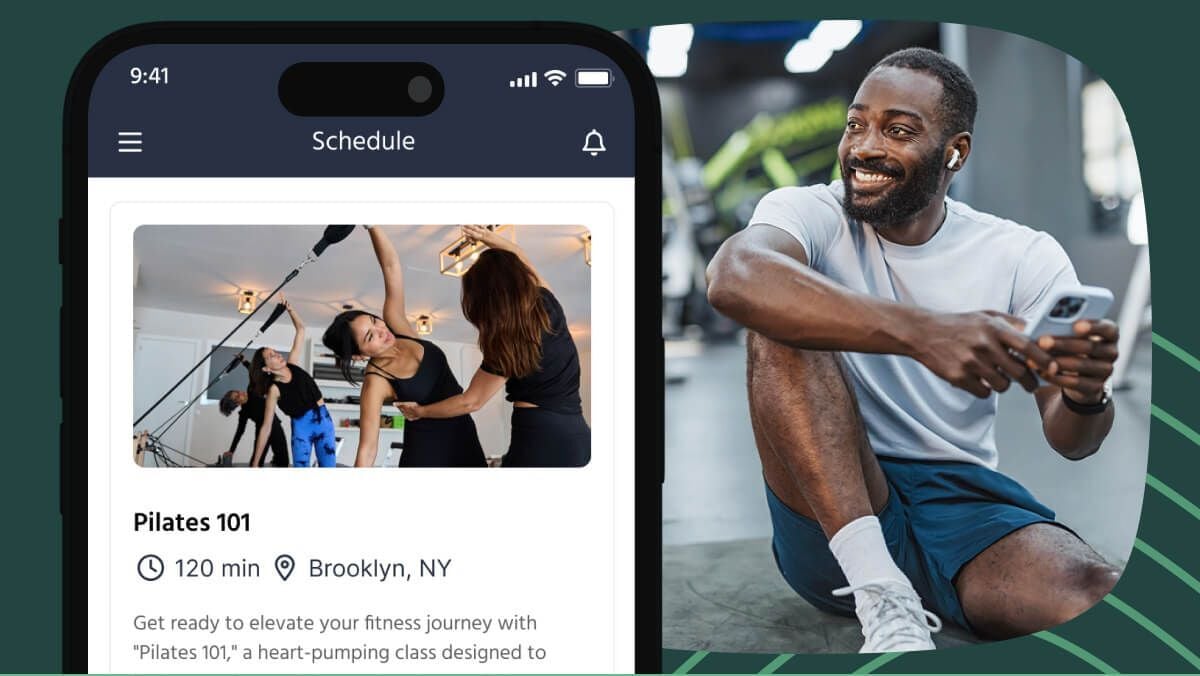For personal trainers, designing a structured workout plan is essential in guiding clients to achieve their fitness goals.
It's not just about the exercises; it's about creating a journey tailored to each client's needs and aspirations.
A thoughtfully crafted workout plan can be the difference between average and outstanding results.
This guide focuses on building workout plans that are adaptable, goal-oriented, and enjoyable, ensuring that clients remain engaged and motivated throughout their fitness journey.
Key takeaways
-
Understand your client's goals and motivations to create personalized workout plans as a personal trainer.
-
Follow exercise principles like progression and specificity to design effective workouts.
-
A well-rounded workout plan includes warm-ups, strength training, cardio, and flexibility exercises.
-
Customize plans to your client's fitness level and adapt them as they progress.
-
Use technology and tools like fitness apps and wearables for better tracking and results.
Fundamentals of a personal trainer workout plan
Creating an effective workout plan for clients requires deeply understanding their goals and needs.
This forms the foundation of your workout plan, influencing the choice of exercises and overall program design.
Understanding client goals and needs
Before crafting a workout plan, it's crucial to have a detailed understanding of what each client aims to achieve.
David Taylor's journey with FitnessMoves highlights this approach.
As an executive experiencing declining fitness, his personalized plan focusing on cardio, metabolic resistance, and strength training led to improved stamina and weight loss. (Source)
This success story emphasizes tailoring workout plans to individual goals and fitness levels.
Remember, it's not just about the physical goals; understanding the client's motivation is key. This helps create a plan that meets their physical needs and aligns with their aspirations.
Principles of exercise programming
Exercise programming principles are crucial for developing effective workout plans. They guide the selection and progression of exercises to achieve desired fitness outcomes.
Case study of progression
Rocky's transformation with Mission:FIT under personal trainer Tim Minnick exemplifies the progression principle.
Starting as a gym novice, Rocky's consistent and gradually more challenging workouts resulted in significant weight loss and health improvements, showing the power of well-planned progression in fitness programs. (Source)
Specificity in training
Lena's success with her specialized restorative yoga plans on Exercise.com illustrates the specificity principle.
Her programs, targeting specific needs like stress relief and flexibility, gained worldwide popularity, proving that specialized training effectively meets unique client needs. (Source)
Components of the workout plan template
A robust workout plan should include warm-ups, cool-downs, strength training, cardiovascular exercises, and flexibility routines for effectiveness and safety.
Warm-up and cool-down
Warm-ups and cool-downs are critical for any workout plan. The American Heart Association says warm-ups improve muscle flexibility and efficiency, reducing injury risks.
They should include light cardio exercises and dynamic stretches like arm and leg swings. Cool-downs are equally crucial for recovery.
They slowly return the body to its resting state and help clear lactic acid buildup. This includes light activities like walking and static stretches.
Strength and resistance training
Strength and resistance training are pivotal in workout plans.
Programs by apps like Nike Training Club often include a mix of compound and isolation exercises for balanced muscle development.
The rep schemes, typically 3–4 sets of 8–12 reps, are adjusted according to the client's goals and fitness levels.
The sequence of exercises is strategically planned for maximum effectiveness.
Cardiovascular training
Cardiovascular training enhances endurance and overall health. Various methods like jogging, cycling, or HIIT are tailored to fit the client's abilities and goals.
The intensity of these exercises is categorized into moderate, vigorous, and maximal effort zones, ensuring a challenging yet safe workout.
Flexibility and mobility exercises
Flexibility and mobility exercises should be part of every workout plan — after all, they are vital for injury prevention and improved movement.
The American Heart Association recommends incorporating exercises like calf stretches for better flexibility.
These routines include both static stretches for joint flexibility and dynamic movements for better mobility and coordination.
Personalization and adaptation
In crafting effective workout plans, personalization and adaptation are crucial because these elements ensure that each plan is tailored to the individual client, leading to better results and greater plan adherence.
Tailoring to individual needs
Customizing workout plans involves understanding each client's unique fitness level, needs, and goals.
For example, a beginner with a sedentary lifestyle might start with a basic cardio and strength training program, gradually increasing the intensity.
In contrast, a seasoned athlete could require a more advanced and varied regimen.
Trainers must analyze their needs to ensure safe and effective progress toward a client's fitness goals.
For example, clients interested in powerlifting but facing exhaustion and mobility problems should focus on improving their conditioning and mobility before moving on to intensive strength training.
When it comes to strength training, it is crucial to adjust sets, reps, and rest.
For example, a client may begin with three sets of eight reps and gradually increase to more sets or higher reps depending on their progress.
This approach ensures continuous challenge and development.
Adapting to progress and feedback
Monitoring and adapting the workout plan according to the client's progress is vital because it ensures that the client is progressing towards their fitness goals and reduces the risk of injury.
For instance, if a client shows rapid improvement in endurance, the trainer might introduce more challenging cardio exercises to enhance their stamina further.
Clients who struggle with certain exercises might find that these are modified or replaced to better suit their abilities.
For example, a trainer might switch from free weights to resistance bands for a client who finds certain weightlifting exercises too challenging.
Planning for progression is also essential.
This might involve setting specific criteria for advancing each exercise, such as achieving a certain number of reps or reaching a particular weight level.
This structured approach keeps the client motivated and progressing steadily.
By integrating these personalized and adaptive strategies, trainers can create workout plans that effectively meet their client's needs and evolve with their progress, leading to more successful training outcomes.
The personal trainer workout plan template
In designing effective workout plans, personal trainers often rely on structured templates as a starting point.
These templates offer a systematic guide for creating comprehensive and balanced workout programs by addressing all critical components of fitness in a well-organized framework.
Detailed template overview
We have three templates for different fitness goals.
They cover all aspects of a well-rounded fitness regimen and can be adapted to suit specific needs.
They're great for personal trainers looking to build effective workout programs for clients of all levels.
Template 1: Personal trainer workout plan
|
Week |
Day |
Focus Area |
Warm-Up |
Main Workout |
Cool-Down |
Notes |
|
Week 1 |
Monday |
Upper body |
10-min light cardio + dynamic stretches |
Circuit: push-ups, pull-ups, dumbbell press (3 sets x 10 reps each) |
5-min stretching |
Focus on form and controlled movements |
|
Week 1 |
Tuesday |
Cardio |
5-min brisk walk |
20-min interval training on treadmill |
5-min walk + stretching |
Alternate between high and low intensity |
|
Week 1 |
Wednesday |
Rest day |
- |
- |
- |
Active recovery: light walking, yoga |
|
Week 1 |
Thursday |
Lower body |
10-min cycling + dynamic leg stretches |
Circuit: squats, lunges, deadlifts (3 sets x 10 reps each) |
5-min lower body stretching |
Ensure proper knee alignment |
|
Week 1 |
Friday |
Core & flexibility |
5-min jump rope |
Planks, Russian twists, yoga poses (3 sets x 10 reps) |
Full body stretching |
Emphasize core engagement |
|
Week 1 |
Saturday |
Mixed circuit |
5-min light jog |
Mix of upper, lower, and core exercises |
Cool down jog + stretching |
Balanced full-body workout |
|
Week 1 |
Sunday |
Rest or light activity |
- |
- |
- |
Optional: light activity like walking or swimming |
Key considerations:
-
Modify the intensity and volume based on the client's fitness level.
-
Include notes on the client's specific requirements or limitations.
-
Ensure a balance of strength, cardio, and flexibility within the plan.
-
Track progress and adapt the plan as necessary.
This template serves as a general framework. Personal trainers can expand it with more specific exercises, sets, reps, and detailed instructions based on their client's individual goals and progress.
Template 2: Cardio-focused workout plan
|
Week |
Day |
Focus Area |
Warm-Up |
Main Workout |
Cool-Down |
Notes |
|
Week 1 |
Monday |
Interval running |
5-min brisk walking |
20-min interval running (1-min sprint, 2-min jog) |
5-min walking + stretching |
Focus on maintaining sprint speed |
|
Week 1 |
Tuesday |
Cycling |
10-min light cycling |
30-min steady-state cycling |
5-min slow cycling + stretching |
Maintain a consistent pace |
|
Week 1 |
Wednesday |
Rest day |
- |
- |
- |
Active recovery: light stretching |
|
Week 1 |
Thursday |
HIIT |
5-min jogging |
HIIT session: 30-sec high-intensity, 1-min rest (20 min total) |
Cool down jog + stretching |
Monitor heart rate |
|
Week 1 |
Friday |
Swimming |
5-min warm-up swim |
30-min mixed stroke swimming |
5-min cool-down swim |
Focus on breathing technique |
|
Week 1 |
Saturday |
Long-distance run |
5-min brisk walking |
45-min steady run |
10-min walking + stretching |
Maintain steady pace |
|
Week 1 |
Sunday |
Rest or active recovery |
- |
- |
- |
Optional: yoga, light walk |
Key considerations:
-
Adjust the intensity based on the client's cardiovascular fitness.
-
Ensure hydration and proper nutrition on training days.
-
Adapt the template for indoor or outdoor settings as needed.
Template 3: Strength and conditioning plan
|
Week |
Day |
Focus Area |
Warm-Up |
Main Workout |
Cool-Down |
Notes |
|
Week 1 |
Monday |
Full-body strength |
Dynamic stretches |
Circuit: deadlift, bench press, squats (4 sets x 8 reps) |
Stretching + foam rolling |
Ensure full range of motion |
|
Week 1 |
Tuesday |
Active recovery |
Light walking |
Bodyweight exercises: push-ups, lunges (2 sets x 12 reps) |
Light stretching |
Focus on recovery |
|
Week 1 |
Wednesday |
Core & stability |
Light jogging |
Core-focused exercises: planks, Russian twists (3 sets x 15 reps) |
Stretching + breathing exercises |
Engage core throughout |
|
Week 1 |
Thursday |
Upper-body strength |
Resistance band exercises |
Weightlifting: shoulder press, pull-ups, bicep curls (4 sets x 8 reps) |
Stretching + foam rolling |
Focus on controlled movements |
|
Week 1 |
Friday |
Lower-body strength |
Light cycling |
Leg day: leg press, lunges, calf raises (4 sets x 8 reps) |
Stretching + foam rolling |
Prioritize form over weight |
|
Week 1 |
Saturday |
Functional training |
Dynamic stretches |
Functional movements: kettlebell swings, box jumps (3 sets x 10 reps) |
Cool down + stretching |
Incorporate balance exercises |
|
Week 1 |
Sunday |
Rest or light Activity |
- |
- |
- |
Optional: light walk, stretching |
Key considerations:
-
Ensure proper form to prevent injuries.
-
Adjust weights and reps based on the client's strength level.
-
Incorporate rest days to allow for muscle recovery.
Implementing the template
To effectively use workout plan templates, assess your client's fitness level and customize the template accordingly.
Personalize the template by adjusting exercises, intensity, and duration based on their progress and feedback.
Regularly review and update the plan to ensure it remains effective and aligned with their fitness goals.
Tracking progress and outcomes
Tracking progress and outcomes is critical in personal training, as it helps gauge a client's development and effectiveness of the workout plan.
Body measurements, fitness assessments, and monitoring exercise performance measure progress.
Adjusting training strategies based on these evaluations is essential for continuous improvement and client satisfaction.
Monitoring client progress
Effectively monitoring client progress is a multifaceted process, combining various methods to track and evaluate fitness goals:
-
Progress reports: Structured progress reports detail the client's training routine, results, and suggestions for future improvements, helping clients focus on their goals and track progress over time.
-
Body measurements and photos: Body measurements and photos offer visual proof of physical progress, which is especially helpful for weight loss or muscle gain goals.
-
Workout or nutrition records: Tracking workouts and food intake helps with accountability, motivation, and identifying areas that affect progress.
-
Technology and software: Personal trainers use personal trainer software and fitness-tracking apps to easily track and modify exercise routines, diet, and body composition.
-
Regular check-ins and feedback sessions: Regular check-ins and feedback sessions are crucial for discussing experiences, challenges, and making timely adjustments to the workout plan.
-
Consistent monitoring and evaluation: Assess the client's performance regularly by evaluating progress towards goals, understanding challenges, and recognizing achievements.
By employing these various methods, personal trainers can effectively monitor their clients' progress, ensuring that workout plans remain aligned with individual goals and adapting them for optimal results.
Adjustments based on evaluation
Adjusting a workout plan is crucial in personal training, as it requires evaluating the client's progress and response to the current regimen.
Regular monitoring and adjustments are crucial for clients to progress toward their fitness goals.
Modify the workout plan if progress is not met by either simplifying exercises or increasing intensity.
For example, replace a challenging exercise with a more manageable alternative.
On the other hand, if a client surpasses their goals, this could signal a readiness for more advanced exercises.
This means gradually increasing the workout's intensity or complexity by adding more weight, reps, or extending cardio sessions.
A real-life example is Scott Pollard, an elite athlete who underwent a personalized 12-week periodization program focusing on fitness and muscle definition.
Scott felt fit halfway through his program, thanks to following personalized training plans. Adjustments should prevent overtraining and balance workout intensity with recovery.
Lastly, clear communication with the client about any changes and explaining the reasons behind adjustments is crucial because it helps maintain their motivation and commitment to achieving their fitness goals.
Additional considerations for workout planning
Effective workout planning encompasses a broader approach beyond exercises and routines, including nutritional advice to align diet with fitness goals and optimize results.
Emphasizing client safety and adapting exercises for injury prevention are also crucial.
These aspects contribute significantly to a fitness program's overall success and sustainability.
Nutritional guidance
Offering your clients basic nutritional advice is crucial for supporting workout plans as it aids muscle recovery and growth and helps manage fatigue during workouts.
Personal trainers should guide clients on a balanced diet, including proteins for muscle repair, carbohydrates for workout energy, and healthy fats for hormone production.
Eating carbohydrates 1–2 hours before a workout is beneficial as it can provide energy and support recovery. Consuming protein within 2–3 hours after a workout can assist in muscle growth. Therefore, meal timing is crucial for a well-rounded exercise routine.
To ensure adherence to the diet plan, it is important to consider the client's preferences and needs while making adjustments and including foods they enjoy.
For instance, a client may be advised to eat a banana or a small serving of oatmeal before a workout and consume a protein shake or chicken salad afterward.
It's important to guide clients on what diet trends work best for them because everyone's body is different, and what works for one person may not work for another.
For example, while intermittent fasting is popular, it might not suit everyone. Personal trainers should refer clients with special dietary needs or medical conditions to qualified professionals.
Client safety and injury prevention
Ensuring client safety and preventing injuries are top priorities because they promote a positive and trustworthy relationship between the service provider and the client.
This involves teaching proper exercise form, supervising workouts, and adjusting intensity and volume.
Consider any medical conditions or injuries your clients may have and adjust their workouts accordingly.
For instance, clients with knee injuries may need to perform low-impact exercises like swimming or cycling instead of high-impact ones.
Clear communication and patience are key when training a client with a chronic injury.
Personal trainers play a vital role in enforcing safe exercise guidelines and making program adjustments for injured clients, such as lowering workout intensity, substituting exercises, or adding more rest days.
Encouraging clients to seek medical advice and follow any rehabilitation recommendations is also crucial.
By applying these principles and examples, personal trainers can provide comprehensive support beyond physical training, covering crucial aspects like nutrition and safety, which are essential for overall client success.
Utilizing technology and tools
Incorporating technology into fitness training enhances the planning, monitoring, and execution of workout programs.
Digital tools like fitness apps and management software streamline the creation and tracking of personalized workout plans.
Wearable technology, like smartwatches and fitness trackers, provides real-time data on health metrics, playing a pivotal role in customizing training sessions to individual needs.
Digital tools for workout planning
TeamUp and other digital platforms provide personal trainers with effective software solutions that offer key features such as workout plan creation, client progress tracking (a vital feature to help decision-making in training), and gym management.
They allow trainers to develop tailored workout programs that can be shared easily with clients through email or mobile apps.
These digital tools enable real-time monitoring of client performance, offering immediate feedback.
This is crucial for identifying areas needing improvement and allows for more responsive adjustments to workout routines.
Integrating wearable technology
Wearable technology provides valuable fitness data, such as smart watches and fitness trackers.
This data can be used to personalize feedback and adjust training programs.
For example, these devices can monitor heart and respiratory rates during exercise, ensuring client safety. Smart clothing can also aid in form and technique analysis during activities like yoga.
In summary, digital tools like TeamUp and wearable technology significantly improve the ability to create personalized and effective fitness programs by adding engagement and accountability to the training process.
Trainers can accurately track progress, dynamically adapt workout plans, and motivate clients to meet evolving fitness goals.
FAQs
What is the key to a successful workout plan for clients?
The key lies in customizing the plan to suit the client's unique goals, fitness level, and preferences.
How often should a personal trainer update a client's workout plan?
Workout plans should be reviewed and potentially updated every 4–6 weeks to align with the client's progress and evolving goals.
What elements are essential in a personal trainer's workout plan?
Essential elements include a warm-up, strength and cardiovascular training, flexibility exercises, and a cool-down.
Can digital tools enhance the creation of workout plans?
Yes, digital tools can streamline plan creation, tracking, and adjustments, making them more efficient and personalized.
How important is it to include client feedback in workout planning?
Client feedback is crucial for tailoring the plan to their needs and preferences, ensuring effectiveness and satisfaction.









.png)
